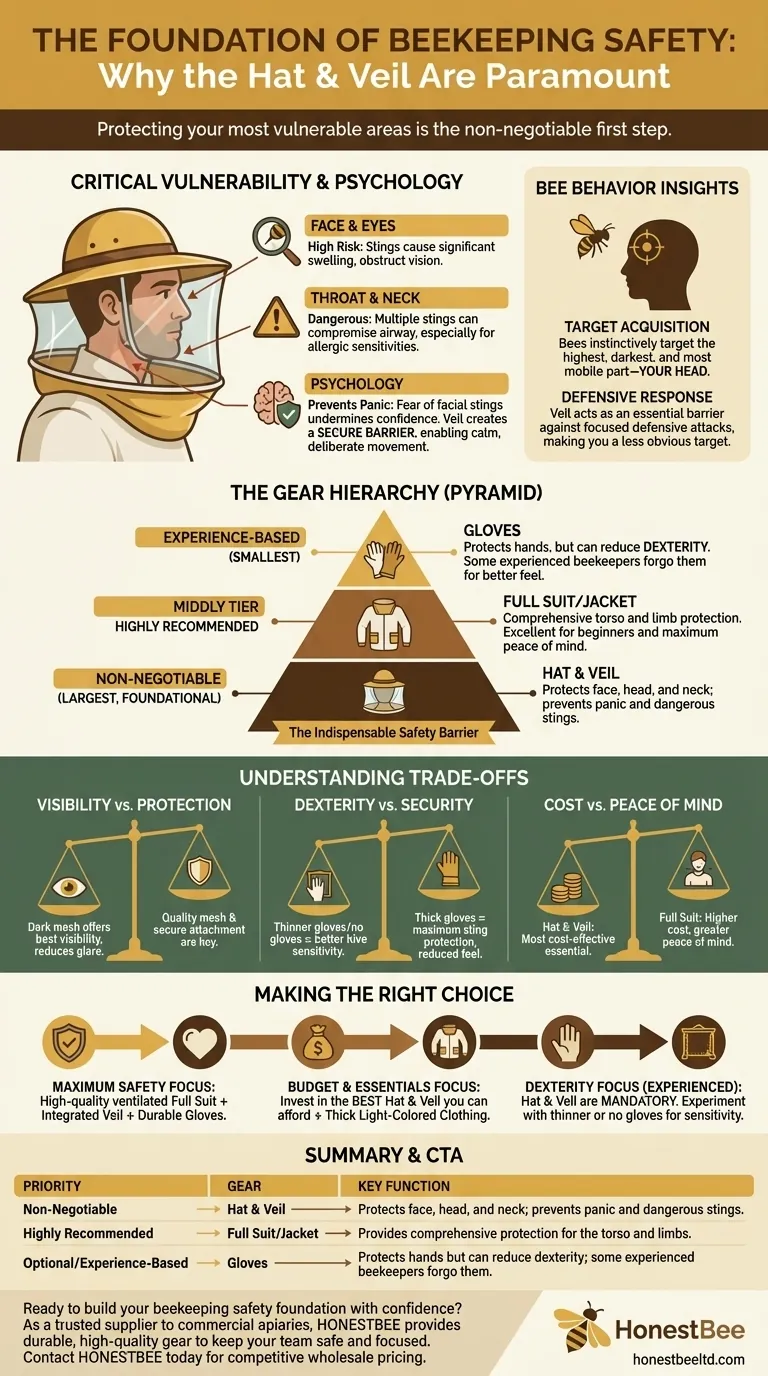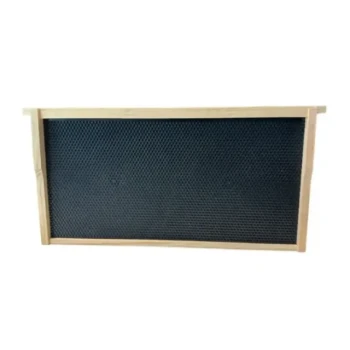At its core, a hat and veil are considered the most important pieces of beekeeping gear because they protect your most vulnerable and physiologically critical areas: your face, head, and neck. While a sting on the hand is painful, a sting near the eye or throat is significantly more dangerous and psychologically disruptive, compromising your ability to work safely and calmly.
While full-body protection provides the most comprehensive safety, shielding your head and face is the non-negotiable foundation of beekeeping. This is because the fear of stings to the face, more than the stings themselves, is what undermines a beekeeper's confidence and focus.

Why Head Protection is Paramount
To understand the priority of the hat and veil, we must look beyond the simple act of preventing a sting and consider both bee behavior and human psychology.
The Critical Vulnerability of the Face
Stings to the face, head, and neck carry elevated risks compared to stings elsewhere on the body. This area contains your eyes, nose, mouth, and airway.
A single sting near an eye can cause significant swelling and obstruct vision, while multiple stings in the neck or facial area can be particularly dangerous, especially for individuals with allergic sensitivities.
Maintaining Calm and Focus
Bees can often be heard buzzing near your head before they become defensive. Without a veil, the natural human reaction is to flinch, swat, or panic.
These sudden movements are perceived by the bees as aggressive actions, which can trigger a defensive response from the entire colony. A veil creates a secure barrier that allows you to remain calm and move deliberately, even with bees flying inches from your face. This calmness is your most effective tool in the apiary.
Bee Defensive Behavior
When bees feel their hive is threatened, they often target the highest, darkest, and most mobile part of the intruder—which is typically your head. This instinct may be a defense against natural predators like bears.
A proper hat and veil assembly, especially one that is light-colored, makes you a less obvious target and provides the essential barrier against this focused defensive behavior.
Comparing Headgear to Other Equipment
Understanding the hierarchy of protective gear demonstrates why the veil is indispensable, while other components can be considered supplemental or dependent on experience.
The Role of Jackets and Suits
Full suits and jackets provide excellent protection for the torso and limbs. They are the next logical step up from the hat and veil for anyone seeking comprehensive coverage.
However, a beekeeper wearing a full suit but no veil is in a far more dangerous situation than a beekeeper wearing only a veil and thick street clothes.
The Function of Gloves
Gloves are essential for protecting the hands and arms, areas that are frequently in the hive. They prevent stings and keep your hands clean.
Yet, many experienced beekeepers work without gloves to increase their dexterity and sensitivity. This allows for more delicate handling of frames, reducing the risk of crushing bees and agitating the hive. No experienced beekeeper, however, would ever consider working without a veil.
Everyday Clothing as a Base Layer
For basic protection, thick, light-colored clothing like denim jeans and long-sleeved canvas shirts can serve as an effective first layer.
Ensuring your pant legs are tucked into boots and your shirt covers your waist when you bend over prevents bees from crawling inside your clothes. This basic setup, when paired with a quality veil, is a common and effective starting point.
Understanding the Trade-offs
Choosing equipment always involves balancing protection, comfort, and cost. Recognizing these trade-offs is key to making an informed decision.
Visibility vs. Protection
The mesh of the veil is a critical component. A black or dark-colored mesh offers the best visibility by reducing glare, making it easier to spot eggs and larvae inside the hive. The quality of the mesh and the security of its attachment to the hat determine its protective effectiveness.
Dexterity vs. Security (The Glove Debate)
The primary trade-off with gloves is dexterity. Thick leather gloves offer maximum protection but can feel clumsy, increasing the chance you might drop a frame. Thinner goatskin gloves or even nitrile gloves offer better feel but less sting protection. As noted, this is a choice based on experience; the veil is not a choice.
Cost vs. Peace of Mind
A hat and veil combination is the most cost-effective piece of specialized equipment. While a full suit offers greater peace of mind and is highly recommended for beginners, its cost can be a barrier. Prioritizing your budget for a high-quality, reliable hat and veil ensures you have the most critical piece of safety gear in place from day one.
Making the Right Choice for Your Goal
Your approach to protective gear should align with your comfort level and beekeeping goals.
- If your primary focus is maximum safety and peace of mind: Invest in a high-quality, ventilated full suit with an integrated veil, and supplement with durable beekeeping gloves.
- If your primary focus is budget and essential protection: Dedicate your resources to the best hat and veil you can afford. This is the one item not to compromise on. Pair it with thick, light-colored clothing secured at the ankles and wrists.
- If your primary focus is dexterity and hive sensitivity (for experienced beekeepers): The hat and veil remain mandatory, but you might experiment with thinner gloves or no gloves at all to improve your ability to work gently and efficiently within the hive.
Ultimately, protecting your head and face is the foundational rule of beekeeping safety that empowers you to be a calmer, more confident, and more effective beekeeper.
Summary Table:
| Priority | Gear | Key Function |
|---|---|---|
| Non-Negotiable | Hat & Veil | Protects face, head, and neck; prevents panic and dangerous stings. |
| Highly Recommended | Full Suit/Jacket | Provides comprehensive protection for the torso and limbs. |
| Optional/Experience-Based | Gloves | Protects hands but can reduce dexterity; some experienced beekeepers forgo them. |
Ready to build your beekeeping safety foundation with confidence?
As a trusted supplier to commercial apiaries and distributors, HONESTBEE provides the durable, high-quality hats, veils, and protective gear you need to keep your team safe and focused. Our wholesale-focused operations ensure you get reliable equipment at competitive prices.
Contact HONESTBEE today to discuss your beekeeping supply needs and get a quote.
Visual Guide

Related Products
- Beekeeper Cowboy Hat and Veil for Beekeeping
- Heavy Duty Cowboy Beekeeper Hat with Visibility Veil Outdoor Professional Beekeeping Protective Gear
- Square Folding Bee Hat Veil with String for Beekeeping
- Cotton Beekeeping Suit and Round Hat with Veil Bee Keeper Protective Gear
- White Beekeeping Protective Suit and Hat with Fencing Veil for Beekeepers
People Also Ask
- What activities is the beekeeping hat suitable for? Beyond the Hive for Ultimate Outdoor Protection
- What are the benefits of the lightweight fabric used in the beekeeping hat veil? Enhanced Visibility & Comfort for Hive Work
- How can beekeeping supplies and accessories enhance the hobby? Essential Tools for Safe & Rewarding Beekeeping
- Why is head protection important for beekeepers? Essential Safety for Confident Hive Management
- What features enhance the quality of the beekeeping veil? Choose the Right Protection for Your Apiary



















